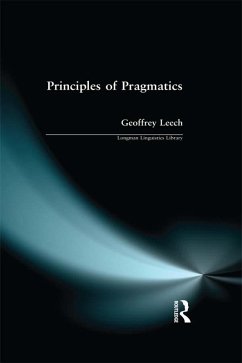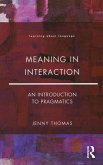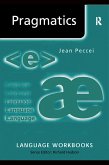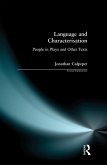Geoffrey N. Leech
Principles of Pragmatics (eBook, PDF)
56,95 €
56,95 €
inkl. MwSt.
Sofort per Download lieferbar

28 °P sammeln
56,95 €
Als Download kaufen

56,95 €
inkl. MwSt.
Sofort per Download lieferbar

28 °P sammeln
Jetzt verschenken
Alle Infos zum eBook verschenken
56,95 €
inkl. MwSt.
Sofort per Download lieferbar
Alle Infos zum eBook verschenken

28 °P sammeln
Geoffrey N. Leech
Principles of Pragmatics (eBook, PDF)
- Format: PDF
- Merkliste
- Auf die Merkliste
- Bewerten Bewerten
- Teilen
- Produkt teilen
- Produkterinnerung
- Produkterinnerung

Bitte loggen Sie sich zunächst in Ihr Kundenkonto ein oder registrieren Sie sich bei
bücher.de, um das eBook-Abo tolino select nutzen zu können.
Hier können Sie sich einloggen
Hier können Sie sich einloggen
Sie sind bereits eingeloggt. Klicken Sie auf 2. tolino select Abo, um fortzufahren.

Bitte loggen Sie sich zunächst in Ihr Kundenkonto ein oder registrieren Sie sich bei bücher.de, um das eBook-Abo tolino select nutzen zu können.
This book presents a rhetorical model of pragmatics: that is, a model which studies linguistic communication in terms of communicative goals and principles of 'good communicative behaviour'. Geoffrey Leech argues for a rapprochement between linguistics and the traditional discipline of rhetoric, maintaining that the language system in the abstract must be studied in relation to a fully developed theory of language use, including politeness, irony, phatic communion, and other social principles of linguistic behavior.
- Geräte: PC
- mit Kopierschutz
- eBook Hilfe
- Größe: 9.77MB
Andere Kunden interessierten sich auch für
![Principles of Pragmatics (eBook, ePUB) Principles of Pragmatics (eBook, ePUB)]() Geoffrey N. LeechPrinciples of Pragmatics (eBook, ePUB)56,95 €
Geoffrey N. LeechPrinciples of Pragmatics (eBook, ePUB)56,95 €![Meaning in Interaction (eBook, PDF) Meaning in Interaction (eBook, PDF)]() Jenny A. ThomasMeaning in Interaction (eBook, PDF)51,95 €
Jenny A. ThomasMeaning in Interaction (eBook, PDF)51,95 €![Meaning and the English Verb (eBook, PDF) Meaning and the English Verb (eBook, PDF)]() Geoffrey N. LeechMeaning and the English Verb (eBook, PDF)51,95 €
Geoffrey N. LeechMeaning and the English Verb (eBook, PDF)51,95 €![Truth and Speech Acts (eBook, PDF) Truth and Speech Acts (eBook, PDF)]() Truth and Speech Acts (eBook, PDF)57,95 €
Truth and Speech Acts (eBook, PDF)57,95 €![Pragmatics (eBook, PDF) Pragmatics (eBook, PDF)]() Jean Stilwell PecceiPragmatics (eBook, PDF)28,95 €
Jean Stilwell PecceiPragmatics (eBook, PDF)28,95 €![The (Un)Translatability of Qur'anic Idiomatic Phrasal Verbs (eBook, PDF) The (Un)Translatability of Qur'anic Idiomatic Phrasal Verbs (eBook, PDF)]() Ali Yunis AldaheshThe (Un)Translatability of Qur'anic Idiomatic Phrasal Verbs (eBook, PDF)40,95 €
Ali Yunis AldaheshThe (Un)Translatability of Qur'anic Idiomatic Phrasal Verbs (eBook, PDF)40,95 €![Language and Characterisation (eBook, PDF) Language and Characterisation (eBook, PDF)]() Jonathan CulpeperLanguage and Characterisation (eBook, PDF)51,95 €
Jonathan CulpeperLanguage and Characterisation (eBook, PDF)51,95 €-
-
-
This book presents a rhetorical model of pragmatics: that is, a model which studies linguistic communication in terms of communicative goals and principles of 'good communicative behaviour'. Geoffrey Leech argues for a rapprochement between linguistics and the traditional discipline of rhetoric, maintaining that the language system in the abstract must be studied in relation to a fully developed theory of language use, including politeness, irony, phatic communion, and other social principles of linguistic behavior.
Dieser Download kann aus rechtlichen Gründen nur mit Rechnungsadresse in A, B, BG, CY, CZ, D, DK, EW, E, FIN, F, GR, HR, H, IRL, I, LT, L, LR, M, NL, PL, P, R, S, SLO, SK ausgeliefert werden.
Produktdetails
- Produktdetails
- Verlag: Taylor & Francis eBooks
- Seitenzahl: 264
- Erscheinungstermin: 17. Februar 2016
- Englisch
- ISBN-13: 9781317869481
- Artikelnr.: 44815357
- Verlag: Taylor & Francis eBooks
- Seitenzahl: 264
- Erscheinungstermin: 17. Februar 2016
- Englisch
- ISBN-13: 9781317869481
- Artikelnr.: 44815357
- Herstellerkennzeichnung Die Herstellerinformationen sind derzeit nicht verfügbar.
Geoffrey N. Leech
Preface
A note on symbols
1. Introduction
1.1 Historical preamble
1.2 Semantics and pragmatics
1.3 General pragmatics
1.4 Aspects of speech situations
1.5 Rhetoric
2. A set of postulates
2.1 Semantic representation and pragmatic interpretation
2.2 Rules and principles
2.3 Convention and motivation
2.4 The relation between sense and force
2.5 Pragmatics as problem-solving
2.6 Conclusion
3. Formalism and functionalism
3.1 Formal and functional explanations
3.2 Biological, psychological, and social varieties of functionalism
3.3 The ideational, interpersonal, and textual functions of language
3.4 The ideational function: discreteness and determinacy
3.5 Examples of 'overgrammaticization'
3.6 Conclusion
4. The interpersonal role of the Cooperative Principle
4.1 The Cooperative Principle (CP) and the Politeness Principle (PP)
4.2 Maxims and Quantity and Quality
4.3 Maxim of Relation
4.4 The Hinting Strategy and anticipatory illocutions
4.5 Maxim of Manner
5. The Tact Maxim
5.1 Varieties of illocutionary function
5.2 Searle's categories of illocutionary acts
5.3 Tact: one kind of politeness
5.4 Pragmatic paradoxes of politeness
5.5 Semantic representation of ddeclaratives, interrogatives and imperatives
5.6 The interpretation of impositives
5.7 Pragmatic scales
5.8 Tact and condescension
6. A survey of the Interpersonal Rhetoric
6.1 Maxims and politeness
6.2 Metalinguistic aspects of politeness
6.3 Irony and banter
6.4 Hyperbole and litotes
6.5 Conclusion
7. Communicative Grammar: an example
7.1 Communicative Grammar and pragmatic force
7.2 Remarks on pragmatic metalanguage
7.3 Some aspects of negation and interrogation in English
7.4 Implications of politeness
7.5 Conclusion
8. Performatives
8.1 The Performative and Illocutionary-Verb Fallacies
8.2 The speech act theories of Austin and Searle
8.3 Illocutionary performatives: descriptive and non-descriptive approaches
8.4 Illocutionary performartives and oratio obliqua
8.5 The pragmatics of illocutionary performatives
8.6 The performative hypothesis
8.7 The extended performative hypothesis
8.8 Conclusion
9. Speech-act verbs in English
9.1 Locutionary, illocutionary, and perlocutionary
9.2 A survey of speech-act verb clauses
9.3 Is there a separate class of performative verbs?
9.4 A semantic analysis of some illocutionary verbs
9.5 Assertive verbs
9.6 Conclusion
10. Retrospect and prospect
References
Index
A note on symbols
1. Introduction
1.1 Historical preamble
1.2 Semantics and pragmatics
1.3 General pragmatics
1.4 Aspects of speech situations
1.5 Rhetoric
2. A set of postulates
2.1 Semantic representation and pragmatic interpretation
2.2 Rules and principles
2.3 Convention and motivation
2.4 The relation between sense and force
2.5 Pragmatics as problem-solving
2.6 Conclusion
3. Formalism and functionalism
3.1 Formal and functional explanations
3.2 Biological, psychological, and social varieties of functionalism
3.3 The ideational, interpersonal, and textual functions of language
3.4 The ideational function: discreteness and determinacy
3.5 Examples of 'overgrammaticization'
3.6 Conclusion
4. The interpersonal role of the Cooperative Principle
4.1 The Cooperative Principle (CP) and the Politeness Principle (PP)
4.2 Maxims and Quantity and Quality
4.3 Maxim of Relation
4.4 The Hinting Strategy and anticipatory illocutions
4.5 Maxim of Manner
5. The Tact Maxim
5.1 Varieties of illocutionary function
5.2 Searle's categories of illocutionary acts
5.3 Tact: one kind of politeness
5.4 Pragmatic paradoxes of politeness
5.5 Semantic representation of ddeclaratives, interrogatives and imperatives
5.6 The interpretation of impositives
5.7 Pragmatic scales
5.8 Tact and condescension
6. A survey of the Interpersonal Rhetoric
6.1 Maxims and politeness
6.2 Metalinguistic aspects of politeness
6.3 Irony and banter
6.4 Hyperbole and litotes
6.5 Conclusion
7. Communicative Grammar: an example
7.1 Communicative Grammar and pragmatic force
7.2 Remarks on pragmatic metalanguage
7.3 Some aspects of negation and interrogation in English
7.4 Implications of politeness
7.5 Conclusion
8. Performatives
8.1 The Performative and Illocutionary-Verb Fallacies
8.2 The speech act theories of Austin and Searle
8.3 Illocutionary performatives: descriptive and non-descriptive approaches
8.4 Illocutionary performartives and oratio obliqua
8.5 The pragmatics of illocutionary performatives
8.6 The performative hypothesis
8.7 The extended performative hypothesis
8.8 Conclusion
9. Speech-act verbs in English
9.1 Locutionary, illocutionary, and perlocutionary
9.2 A survey of speech-act verb clauses
9.3 Is there a separate class of performative verbs?
9.4 A semantic analysis of some illocutionary verbs
9.5 Assertive verbs
9.6 Conclusion
10. Retrospect and prospect
References
Index
Preface
A note on symbols
1. Introduction
1.1 Historical preamble
1.2 Semantics and pragmatics
1.3 General pragmatics
1.4 Aspects of speech situations
1.5 Rhetoric
2. A set of postulates
2.1 Semantic representation and pragmatic interpretation
2.2 Rules and principles
2.3 Convention and motivation
2.4 The relation between sense and force
2.5 Pragmatics as problem-solving
2.6 Conclusion
3. Formalism and functionalism
3.1 Formal and functional explanations
3.2 Biological, psychological, and social varieties of functionalism
3.3 The ideational, interpersonal, and textual functions of language
3.4 The ideational function: discreteness and determinacy
3.5 Examples of 'overgrammaticization'
3.6 Conclusion
4. The interpersonal role of the Cooperative Principle
4.1 The Cooperative Principle (CP) and the Politeness Principle (PP)
4.2 Maxims and Quantity and Quality
4.3 Maxim of Relation
4.4 The Hinting Strategy and anticipatory illocutions
4.5 Maxim of Manner
5. The Tact Maxim
5.1 Varieties of illocutionary function
5.2 Searle's categories of illocutionary acts
5.3 Tact: one kind of politeness
5.4 Pragmatic paradoxes of politeness
5.5 Semantic representation of ddeclaratives, interrogatives and imperatives
5.6 The interpretation of impositives
5.7 Pragmatic scales
5.8 Tact and condescension
6. A survey of the Interpersonal Rhetoric
6.1 Maxims and politeness
6.2 Metalinguistic aspects of politeness
6.3 Irony and banter
6.4 Hyperbole and litotes
6.5 Conclusion
7. Communicative Grammar: an example
7.1 Communicative Grammar and pragmatic force
7.2 Remarks on pragmatic metalanguage
7.3 Some aspects of negation and interrogation in English
7.4 Implications of politeness
7.5 Conclusion
8. Performatives
8.1 The Performative and Illocutionary-Verb Fallacies
8.2 The speech act theories of Austin and Searle
8.3 Illocutionary performatives: descriptive and non-descriptive approaches
8.4 Illocutionary performartives and oratio obliqua
8.5 The pragmatics of illocutionary performatives
8.6 The performative hypothesis
8.7 The extended performative hypothesis
8.8 Conclusion
9. Speech-act verbs in English
9.1 Locutionary, illocutionary, and perlocutionary
9.2 A survey of speech-act verb clauses
9.3 Is there a separate class of performative verbs?
9.4 A semantic analysis of some illocutionary verbs
9.5 Assertive verbs
9.6 Conclusion
10. Retrospect and prospect
References
Index
A note on symbols
1. Introduction
1.1 Historical preamble
1.2 Semantics and pragmatics
1.3 General pragmatics
1.4 Aspects of speech situations
1.5 Rhetoric
2. A set of postulates
2.1 Semantic representation and pragmatic interpretation
2.2 Rules and principles
2.3 Convention and motivation
2.4 The relation between sense and force
2.5 Pragmatics as problem-solving
2.6 Conclusion
3. Formalism and functionalism
3.1 Formal and functional explanations
3.2 Biological, psychological, and social varieties of functionalism
3.3 The ideational, interpersonal, and textual functions of language
3.4 The ideational function: discreteness and determinacy
3.5 Examples of 'overgrammaticization'
3.6 Conclusion
4. The interpersonal role of the Cooperative Principle
4.1 The Cooperative Principle (CP) and the Politeness Principle (PP)
4.2 Maxims and Quantity and Quality
4.3 Maxim of Relation
4.4 The Hinting Strategy and anticipatory illocutions
4.5 Maxim of Manner
5. The Tact Maxim
5.1 Varieties of illocutionary function
5.2 Searle's categories of illocutionary acts
5.3 Tact: one kind of politeness
5.4 Pragmatic paradoxes of politeness
5.5 Semantic representation of ddeclaratives, interrogatives and imperatives
5.6 The interpretation of impositives
5.7 Pragmatic scales
5.8 Tact and condescension
6. A survey of the Interpersonal Rhetoric
6.1 Maxims and politeness
6.2 Metalinguistic aspects of politeness
6.3 Irony and banter
6.4 Hyperbole and litotes
6.5 Conclusion
7. Communicative Grammar: an example
7.1 Communicative Grammar and pragmatic force
7.2 Remarks on pragmatic metalanguage
7.3 Some aspects of negation and interrogation in English
7.4 Implications of politeness
7.5 Conclusion
8. Performatives
8.1 The Performative and Illocutionary-Verb Fallacies
8.2 The speech act theories of Austin and Searle
8.3 Illocutionary performatives: descriptive and non-descriptive approaches
8.4 Illocutionary performartives and oratio obliqua
8.5 The pragmatics of illocutionary performatives
8.6 The performative hypothesis
8.7 The extended performative hypothesis
8.8 Conclusion
9. Speech-act verbs in English
9.1 Locutionary, illocutionary, and perlocutionary
9.2 A survey of speech-act verb clauses
9.3 Is there a separate class of performative verbs?
9.4 A semantic analysis of some illocutionary verbs
9.5 Assertive verbs
9.6 Conclusion
10. Retrospect and prospect
References
Index







